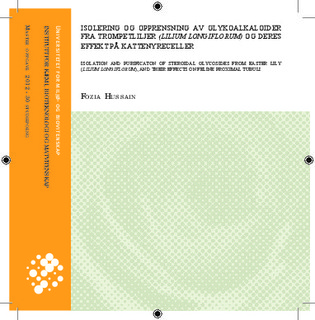| dc.description.abstract | Trompetliljer (Lilium longiflorum) blomstene er mye benyttet i tradisjonell medisin i de asiatiske landene, og de fine attraktive blomstene er veldig populære til bruk som (inne) dekor til blant annet fester og som hageplanter. Uheldigvis har både bladene og blomstene vist å ha svært toksisk effekt på katter som knasker på disse. Trompetliljer er en god kilde til “steroide glykoalkaloider” (SGA) som er sekundære metabolitter. Tidligere har det vært påvist at glykoalkaloider fra potetene har toksiske effekter på dyr, men eksakt toksisk dose og stoffet i trompetliljer som er ansvarlig for tilstanden til kattene er fortsatt ukjent. I dette studiet ble seks grupper av SGA med en molekylvekt på 575, 883, 925, 967, 969 og 1011 Da studert ved bruk av massespektrometriske teknikker (ionefelle-massespektrometri, ITMS, og høytoppløsende massespektrometri, HRMS). Screening og multiple fragmenteringsforsøk ble gjennomført ved HPLC på en Kinetex C18 kolonne (Phenomenex, 50 x 2.1 mm i.d., 2.6µm) koblet til et lineært ITMS, mens HRMS-analyser ble gjort på et kvadrupol-time-of-flight MS (Q-TOF-MS). MS analyse viste at ekstraktet inneholdt minst 18 forkjellige SGA. Glykoalkaloidene ble ionisert med electrospray ionisering (ESI) i disse forsøkene. Enkelte isomerer ble isolert fra et metanolekstrakt fra L. longiflorum blomster med en opprensingsprosedyre som bestod av væske-væske ekstraksjon, kolonnekromatografi på silikagel og videre opprensing med semi-preparativ HPLC på en Luna C18 og en Luna C18(2) kolonne (Phenomenex, begge 250 x 10.00 mm i.d., 10 µm)
En seperat metode for identifisering av sukkerne i SGA ble etablert basert på LC-APCI-ITMS- og optimalisert med standarder av heksoser, en deoksy-heksose og pentoser. Sukkermolekylene ble redusert med borhydrid og deretter acetylert med eddiksyreanhydrid. Utførelse av samme metode på SGA prøve inkluderte en syrehydrolyse før reduksjon og acetylering. Til dette formålet ble en Kinetex C18 (100 x 4.6 mm i.d., 2.6 µm) kolonne brukt.
NMR spektroskopi ble foretatt med kommersiell solasodine og SGA MW 883(1a) og pyridine-d5 brukt som løsningsmiddel. SGA 1a viste seg å være et tidligere kjent SGA fra planten, (22R, 25R)-spirosol-5-en-3β-yl O-α-L-rhamnopyranosyl-(12)-β-D-glucopyranosyl-(14)-β-D-glucopyranoside og en av MW 925 isomerene er sannsynligvis (22R, 25R)-spirosol-5-en-3β-yl O-α-L-rhamnophyranosyl-(12)-[6-O-acetyl-β-D-glucopyranosyl-(14]-β-D-glucopyranoside som også er tidligere kjent fra trompetliljen. Alle SGA analysert i denne oppgaven har solasodine, MW 413, som sitt aglykon bundet til en heksose som videre er bundet til både en heksose og en deoksy-heksose. SGA som ble forsøkt basehydrolysert reagerte til SGA MW 1a og 883(2a), noe som bekreftet MS-analysene, men metylering av de antatte karboksy-SGA med diazometan ga imidlertid ingen resultater.
Forsøk med CCL-94 celler som ble eksponert med løsninger laget av kommersiell solasodine, SGA MW 575 og 1a (alle løst i DMSO), ga ikke konkret svar på om antall sukkermolekyler i SGA resulterte i en økning i toksisiteten, men dose-respons kurven indikerte at 883(1a) var mer toksisk enn SGA MW 575.
Easter lily (Lilium longiflorum) flowers are widely used in traditional medicine in Asian countries, and the fine attractive flowers are very popular for use as (indoor) decoration such as parties as well as garden plants. Unfortunately both the leaves and flowers have shown to be very toxic for cats that chew on them. The Easter lilies are a rich source of secondary metabolites, among them steroidal glycoalkaloids (SGA). Earlier studies recorded that steroidal glycoalkaloids (found in potatoes), had toxic effects in animals, but the exact toxic dose and compound(s) in Easter lilies responsible for the observed toxicity in cats is still unknown. In this study, mass spectrometric techniques (ion-trap mass spectrometry, ITMS, and high resolution mass spectrometry, HRMS) were used for analysis of six groups of steroidal glycoalkaloid analogues with molecular weights 575, 883, 925, 967, 969 and 1011 Da Screening and multiple fragmentation of SGA were performed by HPLC using a Kinetex C18 column (Phenomenex, 50 x 2.1 mm i.d., 2.6µm) connected to a linear ITMS. HRMS analysis was conducted using quadrupole- time-of-flight mass spectrometry (Q-TOF-MS). Electrospray ionization in the positive mode was employed for ionization of SGA for analysis with these techniques. Several isomers were isolated from a methanol extract from L. longiflorum flowers with a clean-up- procedure consisting of liquid/liquid extraction, column chromatography on silica gel and further clean-up with semi-preparativ HPLC on a Luna C18 and a Luna C18(2) column (Phenomenex, both 250 x 10.00 mm i.d., 10 µm).
A method for identification of the sugar moiety in SGA has been developed based on LC-APCI-ITMS and optimized with standards of hexoses, one deoxy-hexose and pentoses. Sugar molecules were first reduced using sodium borohydride followed by acetylation with acetic anhydride. The same method was thereafter applied on samples containing SGA, but including an extra step of acetic hydrolysis of SGA before reduction and acetylation. For LC-MS analyses of the reaction products a Kinetex C18 column (100 x 4.6 mm i.d., 2.6 µm) was used.
NMR spectra were obtained for commercial solasodine and SGA MW 883 (1a). Spectra were acquired in pyridine-d5. SGA MW 883( 1a) turned out to be an SGA earlier reported as (22R, 25R)-spirosol-5-en-3β-yl O-α-L-rhamnopyranosyl-(12)-β-D-glucopyranosyl-(14)-β-D-glucopyranoside, and one of MW 925 isomers is most likely (22R, 25R)-spirosol-5-en-3β-yl O-α-L-rhamnophyranosyl-(12)-[6-O-acetyl-β-D-glucopyranosyl-(14]-β-D-glucopyranoside, which was identified in previous studies of Easter lilies. SGA analyzed in this study all have solasodine as their aglycon bound to a hexose, which is further linked to both a hexose and deoxy-hexose moiety. Results of hydrolyse reaction with a bicarbonate buffer carried on some SGAs showed that these SGAs reacted to 1a and 883 (2a) and this confirmed MS-analysis results in this study. Methylation of carbonyl group in SGAs, which were assumed to have a carboxy function, using diazomethane, gave however no results.
Bio-assays with CCl-94 cells were performed by exposing the cells to standard solutions of commercial solasodine, SGA MW 575 and 1a. The solvent used for preparation of standards was dimethyl sulfoxide. The results did not indicate if the number of sugar molecules in SGA is of importance for their toxicity, but dose-response plots did indicate that 1a was more toxic than SGA MW 575. | no_NO |
